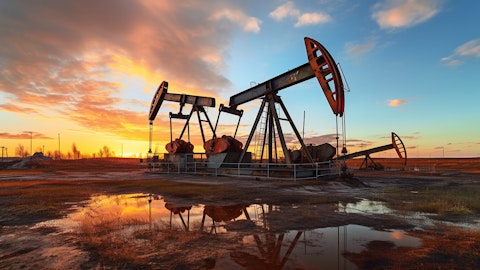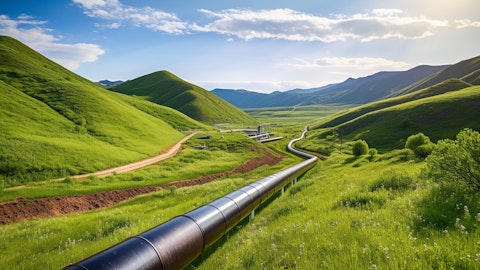The one thing about the M is you need to identify whether or not it has a good barrier between it and the upper Wolfcamp. If there is, you can go ahead and develop that target independently, but in many of our areas that we are going to be developing the Wolfcamp this year, it’s really optimal to codevelop those two targets together. And this is just strategic really to minimize any kind of depletion in these sections and maximize the value of each one of those targets. As a reminder, the Wolfcamp M does have more associated gas, but it’s also a very, very prolific oil producer. It’s got premium returns and the wells pay out in about eight months. So our goal in the Permian or any kind of stacked pay basins is always going to be to continue to execute a codevelopment strategy and really just focus on maximizing returns and NPV.
And I’m sorry, I think I said 2025, I meant 2024 program.
Operator: The next question comes from Neil Mehta of Goldman Sachs. Please go ahead.
Neil Mehta: Yeah. Thanks, Ezra and team. First question on just going back to the macro, I think we’ve been surprised by the supply of natural gas from the U.S. over the course of the last six months. And one of the areas has been associated Permian supply. And so, Ezra, I love your perspective on how you see that evolving, especially as some of the wells mature, but maybe as U.S. production declines on the other side of it. And how that all ties into the way you’re thinking about mid-cycle views on gas?
Ezra Yacob: Yeah. Thanks, Neil. That’s a good point. I think you will continue to see — so far our models is here for U.S. growth might start there since we’re going to be talking about associated gas is really where your question is. It’s roughly around a 500,000 barrel total liquids. So roughly say 300,000 barrels more along the crude oil. And obviously, the significant amount of that is going to be coming out of the Permian, which in general, that basin is a little bit higher GOR than some of the historical plays like the Eagle Ford and the Bakken that we’ve had. And I think you’ll continue to see — our model would suggest you’ll continue to see an increase in the associated gas and more than likely a bit more of a differential struggles there with Waha.
We take that into consideration when we’re thinking about the development of Dorado. Like I said, you can’t forecast a supply and demand or forecast future gas, mid-cycle gas prices without having a recognition of what’s happening on the oil side. It’s one of the things that makes forecasting gas so difficult. So the ultimate thing, the way that we manage our business and we’re trying to grow this gas asset in concert with our oil plays is to really think about being the absolute low-cost producer. And that’s one reason you haven’t seen us ramp up aggressively in the Dorado asset. It’s one reason you’ve seen us last year and this year moderate activity, because we’ve captured a significant resource. We think geographically it’s located a place that gives us significant advantage.
We’ve invested in some additional infrastructure, including the Dorado pipeline that’s named Verde, that’s going to give us a margin expansion over the life of that asset. And that’s really the way that we’re focusing on developing a pure gas asset is really in concert with the growing future North American demand, which is dominantly driven from the LNG there along the Gulf Coast.
Neil Mehta: Thanks, Ezra. The follow-up is you have a different strategy than many of your peers. We’ve seen so much consolidation in the conventional space in the last year, and you’ve got a much more organic approach. And I guess I wanted to give you an opportunity to talk to the investor base about why you think that is the right strategy and what are the pluses and minuses that come with that strategy.
Ezra Yacob: Yeah. Well, as we’ve talked about before, we’re focused on creating shareholder value through the cycles. And the consistent way that we’ve been able to generate that value is through organic exploration, a focus on low-cost operations and a commitment to capital discipline. We have a high level of confidence in our existing portfolio, and it’s aimed at improving the financial performance of the company. And again, I think you can see that with expanded margins and expanded free cash flow in that three-year scenario we provided. It’s underpinned with a 10 billion barrel of equivalent premium resource. And we have meaningful upside with that resource, not only through future conversions, future exploration, but also just through the Utica resource that we’ve already captured and we’ve begun discussing.
When you think about our organic exploration effort, our first mover advantage on the three emerging assets, the Dorado North Powder — I’m sorry, Powder River Basin and the Utica, those three individual assets have the ability to represent, the equivalence of a smaller midsize E&P company, quite frankly. Dorado with 160,000 acres and approximately 20 TCF captured, the Powder River Basin with multiple targets across 380,000 acres, and the Utica asset with over 400,000 acres. So we continue to focus on improving the inventory, not just expanding it. Unproven resources, we do think trade at a wider discount these days than what proven resources do. And so we’re focused on continuing to prove up and drive down the cost of these assets and bring them forward to create that value for our shareholders.
Operator: The next question comes from Brad Brackett of Bernstein Research. Please go ahead.
Brad Brackett: Good morning. And thinking about the Utica, I look at the 90-day cubes. You can put a reasonable price against those volumes and compare it to a reasonable well cost, and it looks quite impressive. And maybe in the old era, that would lead to a flag dropping and a huge ramp in activity in volumes. Is there something that’s governing the pace at which you develop the Utica? And maybe it’s corporate strategy, or maybe it’s gas takeaway, or maybe it’s just getting costs of wells down. And will we ever see the sort of off to the races ramp that we saw in the old days in emerging shale plays?
Lloyd Helms: Yeah, Bob. This is Billy. Yeah, thanks for the recognition there for the Utica. We’re very excited about that play, and the performance of the wells that we’ve tested across the play seem to continue to meet or beat our type curve. So we’re very pleased with that. We haven’t given you a lot of details on the cost yet, but we continue to drive down our cost through increased efficiency gains. And early in any play, you do a lot of testing and a lot of science gathering data. And we expect to see that cost come down. And we haven’t really given you a lot of color yet on the EUR of those wells yet either, because we don’t have but just a handful of wells with limited production data. And we want to gather more time before we can give you some answers.
But I guess from all that, we still feel very confident that our previous estimates of being in that $5 finding cost range look very strong. And we’re still committed to that. And on top of that, as far as the ramp up and how we expect to see that continuing, as we gather more data, we get more confidence and we can be more diligent about how we want to choose to ramp to make the most cost-efficient way we can develop that asset. So we simply don’t need to ramp up any single asset very aggressively. And that’s why you don’t see us — I mean, that’s the advantage of being in a multi-basin portfolio is you’re not required to grow or meet certain targets out of one asset. We have the flexibility that provides us to grow gradually in pace with our learnings so we don’t outrun our learning curve.
And we can be the most efficient operator in any of those basins.
Brad Brackett: And maybe there’s never a huge incentive from your shareholder base that goes and tells you, hey, go build some gas pipe take-away, ramp this thing to 100,000 barrels a day. So we might never see sort of those huge levels of growth from the previous era.
Lloyd Helms: Yeah. I think you wouldn’t see the same levels of growth you saw in the past. I think our strategy would be to grow at a pace that’s commensurate with our understanding of the resource, how to best develop it over the long term for our shareholders, and bring that value forward the best. We don’t want to destroy value either by running too fast. So that’s the balance here is we want to develop at a pace that is commensurate with our understanding of each asset.
Operator: The next question comes from Roger Reed of Wells Fargo Securities. Please go ahead.
Roger Reed: Yeah. Thanks. Good morning. I’d like to come back a little bit more on the well efficiencies, kind of the well costs as you look at ’24 versus ’23,the longer lateral links. Just where should we think about that occurring? You just mentioned multi-basin, right? So is the lateral improvement or increase coming mostly out of the Delaware? Is it spread across all the operations? And what are, either opportunities or limitations on further expansion of the lateral links?
Jeffrey Leitzell: Yeah, Roger, this is Jeff. Thanks for the question. So the lateral links have been a pretty big driver in our efficiency gains. We’ve had an opportunity to test longer laterals over the last few years pretty much throughout our multi-basin portfolio, and all of them with good success. So based on — basically drilling longer where it’s applicable based on our acreage footprint. And that’s one of the limiting factors that we run into. In San Antonio, we’ve talked about, the years, our 15 years of drilling there, we’ve moved from the east, which has a little bit more robust geology out to the west, which has a little lesser geology. But we’ve been able to really optimize the economics there by utilizing longer laterals and really pushing our completion techniques to improve operational and capital efficiencies.
And we’re continuing to do that this year. So we’re seeing some extension there in the Eagle Ford. In the Utica, we’ve talked about, we’ve been doing delineation up and down the 140-mile oily fairway there. And now we’re starting to move into spacing packages and then just package development. So the majority of those wells are going to be three miles moving forward. So that’s an increase in the overall lateral length of the company there. And then in Midland, we’ve been testing three-mile laterals for the last couple of years, but not really in high volume. Last year we drilled about four or five of them. And we’ve seen really good success. And we’ve been able to find the correct blocks and places that works with our acreage. We’re going to increase that to about over 53-mile laterals there in Midland.
So when you kind of roll it all up across the company, the overall lateral length will be up about 10% versus 2023 program. And we talked about, with those efficiency gains from the lateral length and just what we’re seeing from some of the stuff Billy talked on the drilling and completion side, we’re going to require that four less rigs and two less frac fleets and then also four less net wells. But all while doing that, we’re still going to be completing a similar amount of total lateral length as we did with our 2023 program. So the way I’d look at it is we’re just riding a lot of momentum with our efficiencies and our lateral lengths coming out of 2023. We’ll just continue to look to build on that in 2024.
Roger Reed: Thanks. There was a lot in that question, so I’ll turn it back there.
Operator: The next question comes from Matthew Portillo of TPH. Please go ahead.
Matthew Portillo: Good morning, all. Just a follow-up question on the marketing side. In the Permian specifically, you highlight the ability to build out the gas processing plant, which lowers your cost structure. I was curious how you see the fairway for long-haul gas takeaway out of the Permian over the next few years. I know Matterhorn will start to clear the basin towards the end of 2024, but it does feel like it remains pretty tight in 2025 and 2026 plus. So just curious what role EOG might play in long-haul takeaway out of the Permian as it relates to potentially taking on some incremental capacity to make sure that gas is able to flow.
Lance Terveen: Yeah, Matthew, good morning. This is Lance. Maybe I’ll start. When you think about just kind of the macro, you’re right. You have Matterhorn that’s coming on, and you’ve had other pipes that have been expanded with like horsepower, right? So we kind of see going in — you’re going to see the basis going to continue to kind of be wide moving this year and probably potentially into next year. But what I would want to really highlight is just we’ve continued to be a leader as we think about like our transportation portfolio. And we have been a part of many of those pipes. So we were actually very early on pushing on those pipes to make sure that we have a pretty significant transportation portfolio for not only the gas, but then also the crude oil.
But from a natural gas standpoint and then the long-haul pipes from an EOG standpoint, we’re very well positioned with over a BCF a day of residue takeaway that hits into what we think are some great markets along the Gulf Coast.
Matthew Portillo: Great. And then maybe as a follow-up question. I just wanted to come back to the Powder, highlighting obviously the opportunity set to delineate the Niobrara, which I think carries an oilier horizon to it. I’m just curious, the learnings you’ve had so far in terms of the drilling environment. I know trying to drive down the well cost has been a big part of improving the economics as well as the productivity uplift you all talked about. And is this just a pause in the overall program? Or should we be thinking about this as potentially a pull of capital permanently towards the Utica going forward?
Jeffrey Leitzell: Yeah, Matt. This is Jeff. No, I wouldn’t look at it as a pause necessarily in the program. I think it’s just a shift. We’ve gathered really good data. We’ve had great results in that Mowry target. We’ve had great efficiency gains and cost improvement. And our plan always was once we were able to gather some really robust data sets on the overlying to go ahead and step into the Niobrara a little bit, which, with that we’ll back off with our packages in the Mowry to do so. So, Niobrara as far as from — in the Mowry from a drilling aspect, they’re a little bit different. The Niobrara is going to be a little bit easier drilling, I would say, compared to the Mowry because the Mowry is deeper. And then also in there you have some [indiscernible] you can get caught into and have some issues.
The Niobrara, on the other hand is — there’s clinaforms [ph] and really we’ve mapped those clinaforms out well to find out what the better producers are. So we really want to be strategic as we mark across our acreage to make sure we’re staying in those right clinaforms. And I think that really has to do with the discipline pace that we’re looking at there in the Powder.
Operator: The next question comes from John Freeman of Raymond James. Please go ahead.
John Freeman: Thanks a lot. Just a follow up on what Scott asked earlier regarding sort of the development in the Delaware Basin. And it’s obviously clear you all are taking a long-term strategy the way that that’s developed with the codevelopment strategy with multiple targets as opposed to just sort of cherry picking, just drilling the oiliest zones because gas is weaker. It does look like those targeted intervals, Wolfcamp oil and the combo, it has moved around a lot kind of each year, not to get too far ahead, but since you did give the three-year outlook. Would it be safe to assume that if you were thinking out ’25, that that sort of shifts a little bit back more towards the oilier zone, just as a nature of the way that you’re codeveloping the package?





